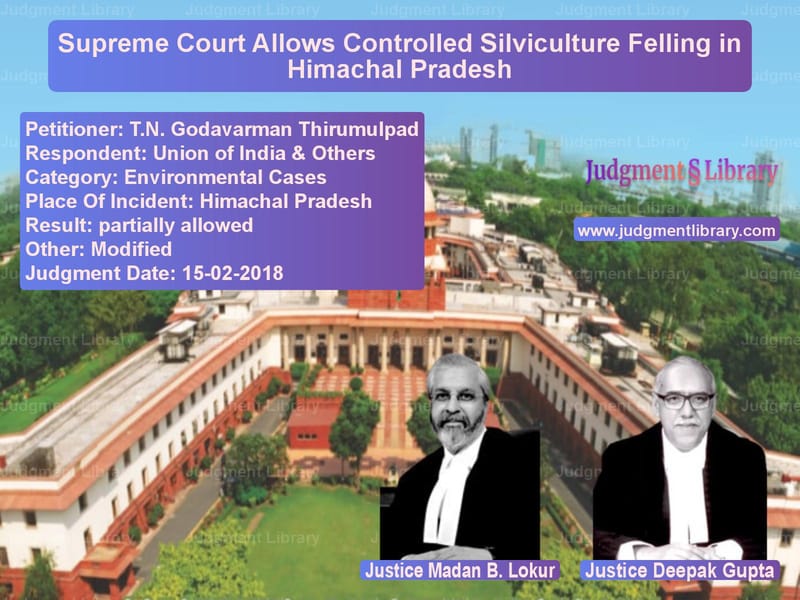Supreme Court Allows Controlled Silviculture Felling in Himachal Pradesh
The Supreme Court of India, in its judgment dated February 16, 2018, ruled on the long-standing forest conservation dispute in the case of T.N. Godavarman Thirumulpad vs. Union of India & Others. The primary issue before the Court was whether the State of Himachal Pradesh should be permitted to carry out silviculture felling in designated forest areas despite an earlier blanket ban on tree felling imposed by the Court.
The Supreme Court, after careful consideration, allowed limited silviculture felling of certain tree species in specific forest ranges under strict conditions. This ruling is seen as a significant step towards balancing environmental conservation with sustainable forestry practices.
Background of the Case
In 1996, the Supreme Court imposed a blanket ban on tree felling in forests across India as part of the landmark T.N. Godavarman Thirumulpad case, which dealt with illegal deforestation and mismanagement of forest resources. The ban aimed to curb rampant deforestation and protect India’s ecological balance.
The State of Himachal Pradesh later sought relaxation of this ban, arguing that controlled silviculture felling was necessary to promote forest regeneration and maintain ecological stability. The State filed an Interlocutory Application (IA No. 3840 of 2014), requesting permission to carry out regulated tree cutting for specific species below an altitude of 1500 meters above Mean Sea Level (MSL).
Key Legal Issues
- Whether the Supreme Court’s 1996 order banning tree felling should be modified for controlled silviculture operations.
- Whether allowing selective felling of trees would enhance forest regeneration or lead to environmental degradation.
- What safeguards and monitoring mechanisms should be implemented if felling is permitted?
Petitioner’s Arguments (State of Himachal Pradesh)
The State of Himachal Pradesh argued:
“Silviculture felling is essential for forest health and regeneration. Without regulated thinning, forests become overgrown, leading to suppressed natural growth and increased vulnerability to pests and wildfires.”
The State submitted that:
- Silviculture operations, including thinning and cultural practices, were necessary for sustainable forest management.
- They sought permission for controlled felling in forests containing Chil Pine, Khair, and broad-leaved trees below 1500 meters.
- The operations would be conducted strictly under the Working Plan approved by the Ministry of Environment & Forests (MoEF).
- All activities would be monitored to prevent commercial exploitation.
Respondent’s Arguments (Union of India & MoEF)
The Union of India and the Ministry of Environment & Forests opposed the request, stating:
“The previous blanket ban on tree felling was imposed due to large-scale deforestation. Any relaxation must be approached with extreme caution to prevent exploitation.”
They contended:
- There was a high risk that allowing silviculture felling would open the door to illegal logging.
- Forest degradation in Himachal Pradesh was already a concern, and permitting felling might exacerbate the issue.
- The ecological impact of tree felling should be studied before granting any relaxation.
Supreme Court’s Decision
The Supreme Court ruled in favor of allowing controlled silviculture felling, stating:
“The purpose of the 1996 ban was to prevent indiscriminate logging. However, scientific forestry management, when implemented responsibly, is in the interest of conservation.”
The Court accepted the recommendations of the Central Empowered Committee (CEC) and imposed the following conditions:
- Silviculture felling is permitted only in Chil Pine, Khair, and Sal forests below 1500 MSL.
- No felling of broad-leaved species is allowed in these compartments.
- A total of 176 hectares of Sal forests, 706 hectares of Khair forests, and 49 hectares of Chil Pine forests were approved for experimental felling in phases.
- Only 25% of mature Khair trees per hectare must be felled, with the rest retained as mother trees.
- At least 40 mature trees per hectare should be retained for Chil Pine and Sal forests.
- No felling will be conducted on steep slopes or near water bodies.
- The felling will be carried out by the Himachal Pradesh State Forest Corporation without involvement of private contractors.
- All felling activities must be videographed for monitoring.
- A two-member oversight committee was appointed to submit reports every six months.
Implications of the Judgment
- Promotes Scientific Forest Management: This ruling acknowledges the importance of silviculture in maintaining healthy forests.
- Ensures Strict Oversight: The Court’s conditions aim to prevent misuse while allowing beneficial felling.
- Sets a Precedent for Future Cases: This judgment may serve as a model for other states seeking controlled forest management.
Conclusion
The Supreme Court’s judgment in T.N. Godavarman Thirumulpad vs. Union of India & Others strikes a balance between environmental conservation and sustainable forestry. By permitting limited silviculture felling under strict monitoring, the Court has taken a scientific approach to forest management, ensuring that conservation efforts remain effective while allowing necessary thinning of forests for regeneration.
This decision marks an important milestone in India’s forestry laws and highlights the judiciary’s role in ensuring both ecological protection and sustainable development.
Petitioner Name: T.N. Godavarman ThirumulpadRespondent Name: Union of India & OthersJudgment By: Justice Madan B. Lokur, Justice Deepak GuptaJudgment Date: 15-02-2018
Don’t miss out on the full details! Download the complete judgment in PDF format below and gain valuable insights instantly!
Download Judgment: T.N. Godavarman Thir vs Union of India & Oth Supreme Court of India Judgment Dated 15-02-2018.pdf
Direct Downlaod Judgment: Direct downlaod this Judgment
See all petitions in Environmental Cases
See all petitions in Public Interest Litigation
See all petitions in Fundamental Rights
See all petitions in Judgment by Madan B. Lokur
See all petitions in Judgment by Deepak Gupta
See all petitions in partially allowed
See all petitions in Modified
See all petitions in supreme court of India judgments February 2018
See all petitions in 2018 judgments
See all posts in Environmental Cases Category
See all allowed petitions in Environmental Cases Category
See all Dismissed petitions in Environmental Cases Category
See all partially allowed petitions in Environmental Cases Category







